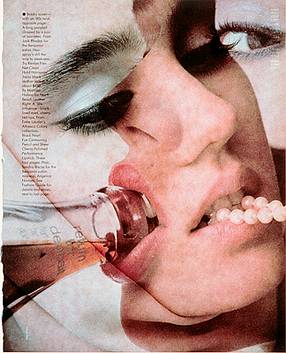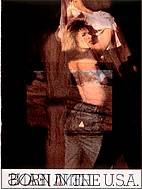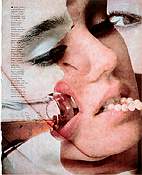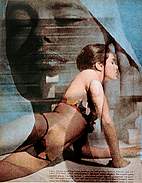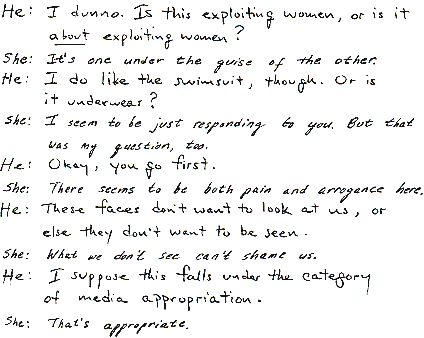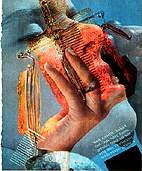| |

In a recent tome about philosophical/psychological alternatives propounded
by the major thinkers of history, the author expended thousands of words
in much earnest wringing-of-hands about The Reason For It All. He impressed
me greatly with his conclusion: "there is something fishy about
human existence."
Trawling around
in these murky depths is Robert Heinecken. And what he catches and offers
for our consumption is redolent of fishiness. This is particularly true
in this portfolio, Recto/Verso, in which seemingly random conjunctions
of unpredicatable factors so consistently create recognizable and significant
images.
Now and again others
have landed similar images by a fluke. There was a bit of a flap a few
months ago when a local woman was startled to see Jesus' face emerging
in a frying taco shell. The taco was consecrated, not consumed, and
the image became a shrine to hundreds of pilgrims. And, if I remember
right, Elvis recently appeared in the mold on an old refrigerator. But
my favorite example is an uncited newspaper clipping pinned up over
the Xerox machine in our art department: a likeness of a patron saint
has miraculously appeared on the scrotum of a fifteen-year-old Italian.
(The account included a photograph of the scrotum image, so it must
be true). Pilgrims are flocking to the blessed house, where the boy,
Giuseppi, displays his holy scrotum through a hole in a screen. Giuseppi
is philosophical about God's visitation: "The Lord has picked my
testicles to do his work," he says. "I wish He had picked
my friend Arturo's, but that's life." It sure is. As Woody Allen
said, "…the Cartesian dictum 'I think, therefore I am' might
be better expressed 'Hey, there goes Edna with a saxophone.'" Image
is more interesting than abstraction.
Both Robert and
Giuseppi share a faith in possibilities; the difference between them,
however, is not one of kind but of consistency. Heinecken seems to have
a psychic resonance with such residual images, which become even more
significant because of their frequency and degrees of latency. As he
has said: "I have the feeling that there are things happening that
are really very interesting, if we can somehow find the key that makes
them visible."
I cannot find an
image of Jesus, Elvis, or even a common saint in the particular Recto/Verso
image assigned to me — but there are plenty of other fishy things
going on. I squint, revolve the page, and all sorts of latent images
are brain developed. There's a squatting nude grinning typographical
teeth, vomiting a sub sandwich (ham and cheese by the look of it) into
a gaping maw with lips pulled apart by a giant's limbs; directing the
flow is a Barbie doll in sunglasses, displaying provocatively enlarged
breasts. A slight turn and there's a voodoo mask chomping on a severed
leg. Turn again, and puckered ruby lips have opened to accept a glowing
cigar butt. A further turn and a graceful swan's head is thrusting its
beak between ivory thighs. And so on…
The "interpretations"
are no less there than the more overt surface manifestations.
As has been already pointed out elsewhere, the title piece of Heinecken's
other, earlier portfolio, Are You Rea, not only includes the
anagrams ARE and REA but also suggests ERA, both for the time in which
we live and the Equal Rights Amendment. There is also the temptation
to complete the word "Rea…" as "Real" or "Ready"
(or even "Reagan"), when the trigger is a woman holding open
her blouse. I can never see this title without associating "You
Rea" with "Eureka," a cry of discovery.
If Robert Heinecken
can dredge these photograms of magazine pages for so many strange, beguiling,
and even meaningful associations and images, the question becomes one
of chance or coincidence. I am referring, of course, to the hoary analogy
of a particularly obsessed monkey eventually typing a Shakespeare play.
Equating the artist with a monkey (even one so tenacious as this) seems
rather insensitive, like Tammy Faye Bakker interviewing an armless woman
on the PTL Club and asking, "Well, how do you put on your makeup?"
I feel justified in posing the above, similarly impertinent question
because I have a point to make which, to me, strikes at the essence
of Recto/Verso.
In order to make
the point I must first introduce a man with the appropriately photographic
name of Kammerer. Paul Kammerer was an Austrian biologist whose professional
passion was the proving of the Lamarckian theory of evolution. (He shot
himself when it was discovered that his prize specimen, the so-called
"midwife toad," had been tampered with to fake the evidence).
Kammerer's avocation had been his conviction that apparent coincidences
are merely tips of an iceberg, which happen to catch our attention.
In other words, he reverses the skeptic's argument that from among myriad
random events we select only those that seem significant. To Kammerer,
"coincidences" are the rule, not the exception. He believed
that there is an as yet undiscovered law which clusters non-causal concurrences
into significant lumps. This, to Kammerer, "is a simple empirical
fact which has to be accepted and which cannot be explained by conicidence
— or rather, which makes coincidence rule to such an extent that
the concept of coincidence itself is negated."
In a beautiful analogy,
Kammerer likened this force to a "cosmic kaleidoscope" that,
in spite of constant shufflings and random rearrangements, also takes
care to bring like and like together — and to create recognizable,
relevant juxtapositions by chance, as in this portfolio.
We may be condemned,
because of our humanness, to play the role of "peeping Toms at
the keyhole of eternity," as Arthur Kosetler says in a similar
analogy, but Robert Heinecken has taken the stuffing out of the hole,
giving us a clearer look at even our limited view. What Heinecken states
as his interest in "residual reality" bears an uncanny resemblance
to Kammerer's "seriality" (and it might be added to Jung's
"synchromicity" and Pauli's "exclusion principle"
and Hardy's "psychic blueprint" and so on). Unfortunately,
such terms sound pretentious as if the idea were too difficult for non-specialists.
As Goethe put is: "When the mind is at sea, a new word provides
a raft." In fact, the principle is simple, if heretical.
What Robert Heinecken
reveals in Recto/Verso is that the explanation of coincidence
just will not wash, that underlying such randomness is a remarkable
symmetry, as if something is trying to tell us something. And that is
not only "bloody fishy," it is also the meaning of art.
|
